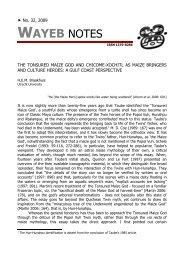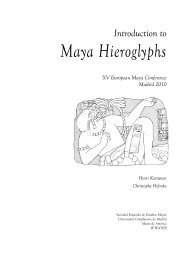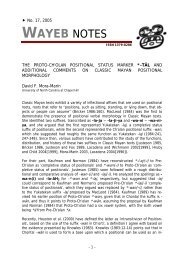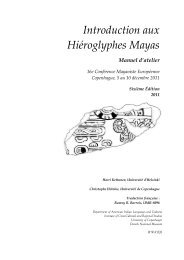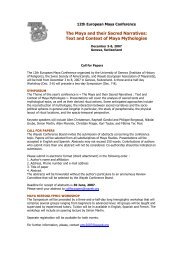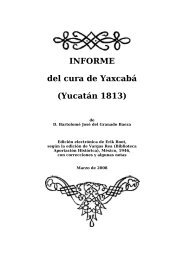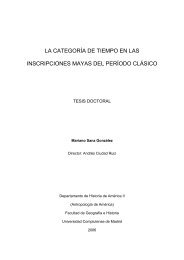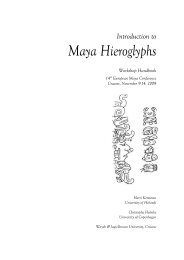Introduction to Maya Hieroglyphs - Wayeb
Introduction to Maya Hieroglyphs - Wayeb
Introduction to Maya Hieroglyphs - Wayeb
Create successful ePaper yourself
Turn your PDF publications into a flip-book with our unique Google optimized e-Paper software.
Kettunen & Helmke 2011<br />
Structure and Content of Texts<br />
19. CODICES<br />
A special class of <strong>Maya</strong> texts is found in the Post-Classic codices (sg. codex). Instead of recording his<strong>to</strong>rical<br />
events, like many of the monumental inscriptions, the content of these texts is more esoteric, astronomical, and<br />
calendrical, information presented in the form of almanacs and prophecies. Four of them have survived the<br />
subtropical weather and 16 th Century Spanish bonfires <strong>to</strong> present day: the codices of Dresden, Madrid, Paris, and<br />
Grolier.<br />
Dating the codices has been a problem ever since they were (re)discovered, and no agreement as <strong>to</strong> their age has<br />
been established <strong>to</strong> date. Determining the age of the codices has been based on stylistic grounds (based on both<br />
iconography and epigraphy), astronomical and calendrical data, linguistics, and radiocarbon dating. Most<br />
scholars (see Vail 2002) agree on the assumption that the Dresden Codex is the oldest of the four surviving<br />
codices and that the Paris Codex can be fairly accurately given a date somewhere around the middle of the 15th<br />
century, but the chronological order of the two remaining codices (Madrid and Grolier) has demonstrated a large<br />
number of variance.<br />
Regarding the dating of the Paris Codex, Love (1994: 13 and 2001: 443) proposes an approxi-mate date of 1450<br />
based on stylistic resemblance <strong>to</strong> the s<strong>to</strong>ne monuments at the Late Postclassic site of <strong>Maya</strong>pan and <strong>to</strong> the art style<br />
of the eastern coast of Yucatan before the Conquest. Also, considering the fragility of paper, paint and plaster in a<br />
tropical environment, Love suggests that the codices confiscated by the Spaniards were probably produced quite<br />
close <strong>to</strong> the time of initial contact, even though the texts themselves were copied from earlier, more ancient<br />
sources (Love 1994:8).<br />
The date of the Madrid Codex is commonly held <strong>to</strong> be somewhere around 15th century (see e.g. Graff and Vail<br />
[2001]). Contrary <strong>to</strong> general concensus, Michael Coe has proposed a much later date for the Madrid Codex in a<br />
presentation in the XXIst <strong>Maya</strong> Hieroglyphic Forum at the University of Texas in 1997. The conclusions were<br />
published in Coe and Kerr (1998: 181) with the assertion that “[…] fragments of European paper with Spanish<br />
writing are sandwiched or glued between layers of bark paper […] the Western paper appears not <strong>to</strong> have been a<br />
mere repair, but <strong>to</strong> have been incorporated in the codex during its manufacture. Thus the Madrid would<br />
necessarily be later than the conquest of Yucatán, probably even post-1624, and could have been made at Tayasal,<br />
which did not fall <strong>to</strong> the Spaniards until 1697.”<br />
37/154



